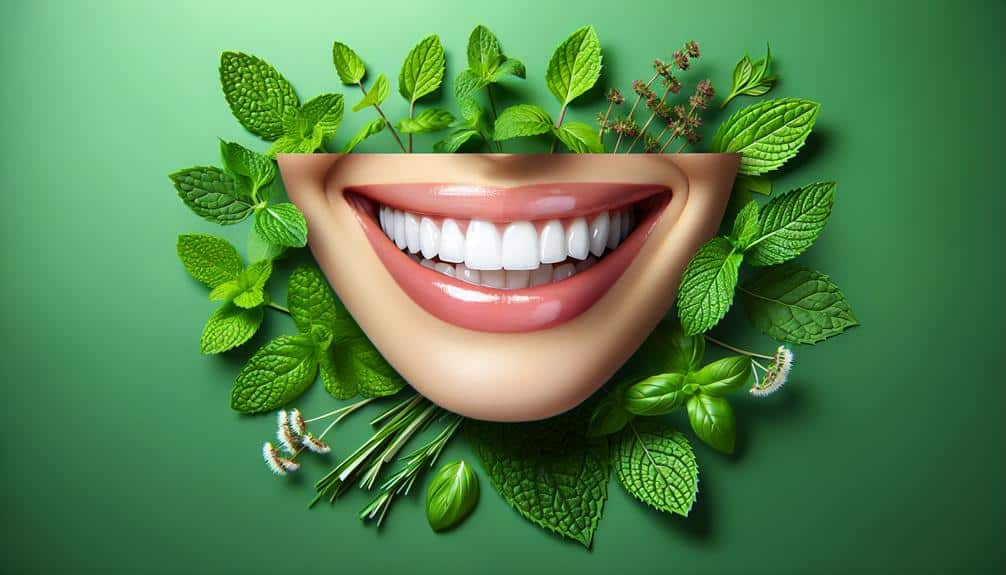Achieve a brighter smile by selecting whitening toothpaste tailored to your needs, whether for sensitive teeth or with natural ingredients like baking soda or charcoal. Opt for reputable brands with fluoride and hydrogen peroxide for effective whitening. Proper brushing techniques, like holding your toothbrush at a 45-degree angle and brushing for at least two minutes, can enhance results. Brush at least twice a day, incorporating whitening toothpaste into your routine while avoiding enamel damage. Remember to contemplate additional whitening tips such as whitening mouthwash and avoiding teeth-staining foods for a truly radiant smile.
Key Points
- Use whitening toothpaste twice daily for optimal results.
- Incorporate proper brushing techniques for effective whitening.
- Consider natural options like baking soda or charcoal toothpaste.
- Limit teeth-staining foods and drinks for lasting whiteness.
- Consult a dentist for guidance on whitening toothpaste use.
Types of Whitening Toothpaste
When selecting a whitening toothpaste, consider the various types available to find one that suits your needs and preferences. Start by comparing the ingredients in different brands. Look for reviews on brands known for their whitening properties to guarantee effectiveness.
If you have sensitivity concerns, opt for a toothpaste specifically designed for sensitive teeth. These options are formulated to be gentle while still providing whitening benefits.
For those interested in natural options, look for toothpaste that utilizes ingredients like baking soda, charcoal, or coconut oil for a more organic approach to whitening. Natural toothpaste can be effective in brightening your smile without the use of harsh chemicals.
Choosing the Right Toothpaste
To select the right toothpaste for your needs, consider your oral health goals and preferences. When comparing ingredients, look for key components like fluoride for cavity protection, hydrogen peroxide for whitening, and baking soda for plaque removal. Different toothpaste formulas cater to specific needs, such as sensitivity relief or enamel strengthening, so choose one that aligns with your goals. Additionally, brand reputation plays an important role in ensuring quality and effectiveness. Opt for well-known brands with a history of producing oral care products backed by science and research.
When comparing toothpaste options, check for seals of approval from dental associations, as these indicate products that meet specific standards for safety and effectiveness. Reading reviews and seeking recommendations from dental professionals can also help you make an informed decision. Remember, the right toothpaste isn't just about whitening; it should address your overall oral health needs. By considering ingredient comparisons and brand reputations, you can select a toothpaste that supports your oral health goals effectively.
Proper Brushing Techniques
For effective oral hygiene, mastering proper brushing techniques is crucial in maintaining a healthy smile. To guarantee you're getting the most out of your brushing routine, follow these key tips:
- Proper Technique: Hold your toothbrush at a 45-degree angle to your gums and use short, gentle strokes. Brush the outer and inner surfaces of your teeth, as well as the chewing surfaces, with back-and-forth motions.
- Timing: Brush your teeth for at least two minutes each time. Set a timer or use a toothbrush with a built-in timer to make sure you're brushing for an adequate amount of time.
- Frequency: Brush your teeth at least twice a day, in the morning and before bed. If possible, brush after meals or snacks to prevent plaque buildup.
- Brushing Habits: Avoid brushing too hard, as this can damage your gums and enamel. Use a soft-bristled toothbrush and replace it every three to four months or sooner if the bristles are frayed.
Frequency of Use
Maintaining good oral hygiene involves brushing your teeth at least twice a day to promote healthy gums and teeth. When it comes to using whitening toothpaste, the frequency of use is key to achieving best results. For best application, it's recommended to brush with whitening toothpaste twice a day, just like with regular toothpaste. This guarantees that your teeth receive consistent exposure to the whitening agents in the toothpaste, helping to break down stains and brighten your smile over time.
Daily maintenance is important when using whitening toothpaste. Consistency is vital, so make sure to incorporate whitening toothpaste into your daily oral care routine. However, it's essential to strike a balance. While using whitening toothpaste daily can help maintain a brighter smile, overuse can lead to enamel damage. Hence, it's advisable to follow the instructions provided on the toothpaste packaging or consult your dentist for personalized guidance on the frequency of use that best suits your oral health needs.
Additional Whitening Tips
Consider incorporating whitening mouthwash into your oral care routine for an added boost in brightening your smile. Whitening mouthwashes often contain ingredients like hydrogen peroxide or fluoride, which can help remove surface stains and prevent new ones from forming.
Here are some additional tips to enhance the whitening effects of your toothpaste:
- Diet Adjustments: Limit foods and drinks that can stain your teeth, such as coffee, tea, red wine, and berries. Opt for a balanced diet rich in fruits and vegetables to promote overall oral health and prevent discoloration.
- Lifestyle Changes: Avoid smoking and tobacco products, as they can cause severe staining on your teeth. Drinking plenty of water throughout the day can also help wash away food particles and reduce the risk of stains.
- Natural Remedies: Try natural teeth-whitening remedies like baking soda or activated charcoal. These can help gently remove surface stains and brighten your smile.
- Professional Treatments: Consider professional whitening treatments from your dentist for more dramatic results. They can provide customized solutions to suit your whitening needs.
Frequently Asked Questions
Can Whitening Toothpaste Cause Sensitivity in Some People?
Using whitening toothpaste may cause sensitivity in some individuals. To manage this, consider whitening alternatives or seek professional advice for sensitivity prevention. Remember, taking care of your oral health is essential for a bright smile.
Are There Any Potential Side Effects of Using Whitening Toothpaste Long-Term?
Long-term use of whitening toothpaste may pose potential risks like enamel damage or gum irritation. Consistent overuse can harm your oral health. Remember, moderation is key for maintaining a healthy smile.
Can Whitening Toothpaste Remove Deep Stains or Discoloration?
Whitening toothpaste can be effective for removing deep stains and discoloration. Its efficacy in treating these issues may vary based on individual factors. Consistent use and proper brushing techniques can help achieve desired results.
How Long Does It Typically Take to See Noticeable Results From Using Whitening Toothpaste?
Want to know how speedy whitening toothpaste works its magic? Results vary based on individual oral hygiene and staining. Typically, noticeable improvements take around 2-6 weeks of consistent use, but the whitening process continues over time.
Are There Any Specific Ingredients to Avoid in Whitening Toothpaste for Those With Sensitive Teeth or Allergies?
When choosing whitening toothpaste for sensitive teeth or allergies, avoid harsh ingredients like peroxide or sulfates. Look for hypoallergenic options with natural alternatives such as baking soda or coconut oil for gentler whitening effects.



